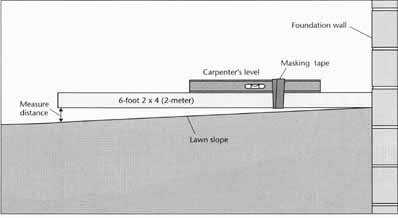If your house has gutters, conduct a complete inspection of the gutter system. The best time to do this is during a moderate to heavy rain, when water is present and you can follow the disposal route from roof to ground level, and then away from the foundation. To inspect the rain gutters with out climbing, use a pair of binoculars to get an up-close view of all the components.
The next step is to inspect the gutters at the roof edge when rain stops. You can do this from the roof, or from ground level if you prefer. Be aware, however, that even a handful of leaves or debris may clog the gutters at the point where they enter the downspouts, so to perform a complete inspection you must position yourself on the roof or on a ladder high enough to visually inspect the entire gutter system.
Be sure the gutters are clean and free of any debris such as leaves, limbs, and twigs. Stain marks on the outsides of the gutters clearly indicate that the gutter system is overflowing along its length. If your gutters clog and overflow frequently, have a professional trim any nearby trees to remove overhanging limbs and deadwood to reduce future debris buildup.
When you are sure the gutters are clean, check the gutter joints to be sure they are not leaking water. Check also to be sure the gutters are large enough to handle the heaviest rainfall without overflowing.
Check the downspouts that carry the water from the gutters to the ground. Be sure the downspouts are open so water can flow freely to ground level. If the down spouts are blocked with leaves, push the nozzle of a garden hose into the down spout and flush out the debris with water pressure.
Now that the roof water can travel to ground level, what will you do with it? Keep in mind that a 1-inch (2.5 centimeter) rainfall will deposit nearly 1,000 gallons (3,785 liters) of water on a 1,500 square foot (139 square meter) roof. A gutter system serving a roof of this size will have need four to six downspouts to carry water from the gutters to ground level. Assuming the water is equally diverted, this means that between 166 gallons (628 liters) and 250 gallons (946 liters) of water will fall to the ground through each downspout. To ensure that the basement stays dry, install longer ground pipes—the pipes at the bottom of the down- spouts—so that the water is diverted at least 10 feet (3 meters) from the foundation when it reaches the ground.
While it's raining, notice how the water exits from the downspouts and flows into the ground pipes. How far away from the foundation is the point at which the water is deposited? What is the water’s path as it flows from the end of the ground pipes? Does the water continue to flow away from the house foundation, or does it run back toward it? Any water that lies in pools or runs back toward the basement foundation is a potential problem.
Be especially careful when checking ground pipes that terminate on a sidewalk, driveway, or patio. Water that's deposited on concrete slabs that are flat, or slope slightly toward the foundation, often will run back toward the house and into the basement. Any concrete or asphalt slabs that are adjacent to the foundation must be sloped so that water runs away from the foundation.
Ground pipes should never terminate in cultivated areas such as flower beds, where the soil is kept loosened and is therefore very absorbent. Large amounts of water will soak through this loose soil and reach the basement wall. The ground pipes must be long enough to deliver the water onto a grassy surface, or onto a sloping concrete slab, such as a driveway, where it will run away from the basement wall.
If you inspect the system during a rainfall, you will be able to track the water flow through the gutter system, onto a paved or grassy area, and down the lawn to the street gutters and storm drains, or to a rain collection basin such as a pond or stream.

Basement Construction on
Wet Soil: To check the grade of your lawn, place one end of a 6-foot (2-meter)
long 2 x 4 against the foundation wall. Raise the outer end of the 2 x 4
until the 2 x 4 is level. Measure the distance between the lawn and the bottom
edge of the 2 x 4: if less than 3 inches (7.5 centimeters), add soil at the
foundation wall to increase the slope.